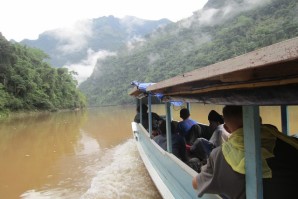Laos includes many intteresting places to visit and alot of things to do such as cycling, hiking, trekking and boating. Especially in the country side of Vientiane province and other provinces as well. Each place we can reach easily such as by bus and bicycles, it takes you only three or four hours by bikes to the places which is in the suburbs or country sides, and four hours by bus to another province like: from Vientiane Capital to Vientiane Province.
Cycling
The overall lack of vehicular traffic makes cycling an attractive proposition in Laos, although this is somewhat offset by the general absence of roads in the first place. For any serious out-of-town cycling you’re better off bringing your own bike, one that’s geared to very rough road conditions.
In term of road gradient and availability of food and accommodation, the easiest long-distance ride is along Rte 13 from Luang Prabang south to the Cambodian border. In the dry season this road may become very dusty even in the paved sections, and trucks – though nowhere near as overwhelming as in Vietnam or Thailand – can be a nuisance. Other cycling routes of potential interest – all of them currently unpaved and rough but due to be upgraded over the next decade – included: Luang Prabang to Muang Khua, Huay Hai to Luangnamtha, Pakse to Attapeu, Muang Xai to Phonsavan, Muang Phu Khun to Phonsavan and Samneua to Phonsavan. The last two routes are quite remote and reauire that you be prepared to camp if necessary along the way.
Hiking and Trekking
The mountainous, forest – clad countryside makes Laos a potentially ideal destination for people who like to walk outdoors. All 17 provinces have plenty of hiking possibilities, although the cautious nature of nature of the authority means that overnight trip involving camping or staying in the villages are viewed with suspicion. However the last couple of years the government has allowed a sprinkling of pilot, multi – day trekking projects, so the situation is gradually changing.
Many visitors trekking on their own have managed to spend the night in remote villages anyway. There doesn’t appear to be any law forbidding this although it is somewhat frowned upon by the authorities in areas such as the provinces of Hua Phan, Sekong and Attapeu.
Day hiking is another story and you’re free to walk in the mountains and forests almost anywhere in the country except the Sailombun special Zone.
The provinces in Laos with the highest potential for relatively safe wilderness hikes include Borkeo, Luangnamtha, Luang Prabang, Vientiane, Khammuan and Champasak.
Except at the occasional waterfall near towns or cities, recreation areas with public facilities are nonexistent in Laos.
Boating
The rivera and streams of Laos has potential for all sorts of recreational boating, particularly rafting, canoeing and kayaking. No modern equipment exists, however, so it’s strictly bring-your-own. Nor are there any regular bamboo raft trips as in Thailand, though the country is prime territory for it.
As with bicycles, you shouldn’t have any special customs difficulties in bringing your own small boat to Laos. Because of the difficulties of overland transport, however, the smaller and lighter your craft is, the more choices you’ll have for places to paddle.
For trained paddlers almost any of the major waterways draining from the western slopes of the Annamite Chain towards the Mekong valley could be interesting. In the north, the Nam ou, Nam Tha, Nam Khan, Nam Ngum and of course the Mekong river are navigable year-round. In central and Southern Laos the Nam Theun, Se Don, Se Set and Se Kong as well as the Mekong are safe bets. The upstream areas of all these rivers can be accessed by road, do drop-offs and pick-ups are limited only by the availability of public or private vehicle travel.

In the area between Vientiane and Tha Khaek, several tributaries which feed into the Mekong are smaller and less known than the aforementioned but very scenic since they run through rugged limestone country. In particular the Nam Xan, Nam Kading and Nam Hin Bun seem to be wide and relatively clean rivers. The choices are somewhat limited by the availability of roads to take you upstream. A company called North-by-Northeast Tour, based in Nakhonephanom, Thailand (directly across from Tha Khaek), has recently begun offering river trips along the Nam Hin Bun and other waterways in the Khammuan limestone.
Between Champasak and the Cambodian border, the area of the Mekong known as Si Phan Done (Four Thousand Islands) is easily accessible and provides superior paddling possibilities among verdant islands and rapids.
There is one big caveat lurking behind reaching what could be paddler heaven: The legalities of floating down Lao waterways are a bit hard to discern. Local people do not need permits of any kind to launch self propelled craft on any stream or river, technically foreigners aren’t subject to any special regulations either, as long as they are not transporting commercial cargo or fee paying passengers. You should be prepared to face the occasional suspicious government official along the way, simply because you are doing something that’s out of the ordinary. Of course if you go with an organized tour, you are less likely to face problems with local officials.



